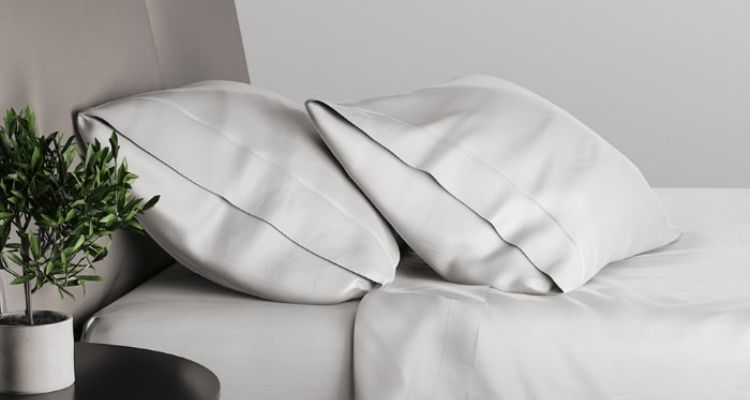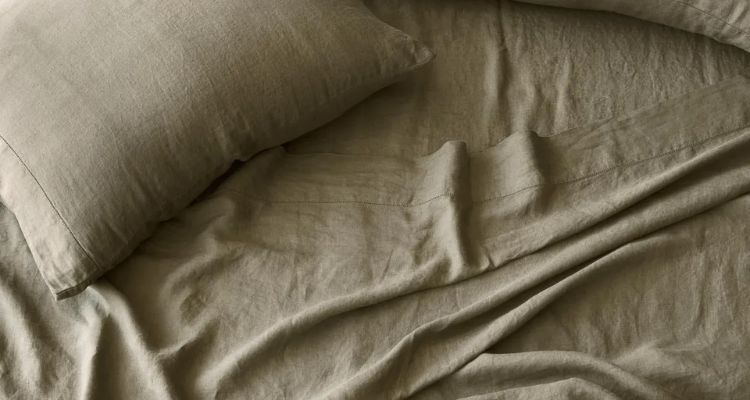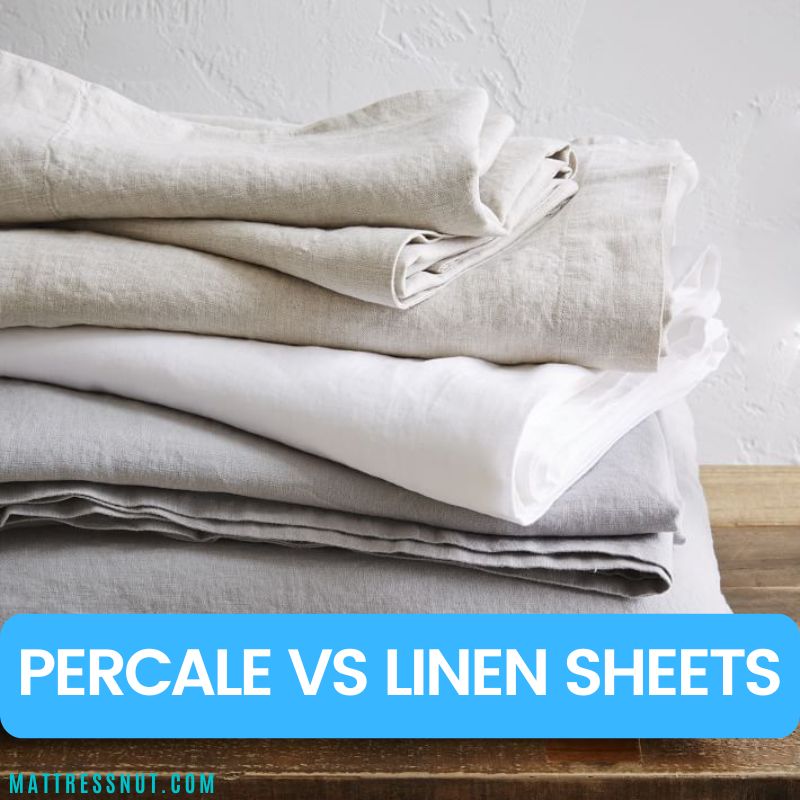You spend a considerable chunk of your life sleeping. This huge chunk is a super important part of your lives, and deciding what kind of sheets to sleep on should be your top priority (check the top rated bed sheets with great comfort).
Sheets play an essential role in helping us fall asleep, so if you are thinking of deciding between percale or linen sheets, have a look at this detailed comparison.
What’s A Percale Sheet?
Percale refers to how a given textile is woven onto the loom, so percale is an essential style used in various materials, especially bedding. The Percale weaves are a one-over-one-under weave that creates a fabric that is airy, light to the touch, and crisp. And this is what makes percale sheets a perfect fit for hot sleepers (also check 10 amazing bed sheets for summer).

Who Should Use a Percale Sheet?
Percale sheets are cool, crisp, light, and airy. They give you the perfect hotel bed feel (also check 10 great hotel mattresses). These sheets are more than just breathable; they actively work to cool you down. If you are a year-round hot sleeper, you would love to use these throughout the year. However, if you are not prone to night sweats or are not a hot sleeper, you might want to save these just for the summer.
The Pros and Cons of a Percale Sheet
Pros:
Percale sheets have a lot to offer. The way this weave is constructed provides a lot of benefits.
Smoothness: percale weave leaves your sheets with a soft and flawless feel that gives you the luxurious feel of a hotel bed (also check 8 top luxury pillows).
Breathable: Percale weave ensures room for a lot of airflows. This, in turn, makes the sheets very breathable and perfect for hot sleepers (also check 10 great cooling mattresses for hot sleeper).
Durable: The percale weave is tightly knit, which lasts longer than other options available. The durability they offer is why most hotels go for percale sheets.
Cons:
Different people like different things and their sleep needs are not alike. What some like might not be suitable for others. Here are some things that you might not like about these sheets.
Wrinkle prone: most percale sheets are made of 100 percent cotton, and cotton is prone to wrinkling. Especially after your machine washes, you might need to iron it first for that famous smooth texture.
Not warm enough: Percale is very lightweight and breathable. It is a great choice for hot sleepers, but if you live in a cooler area or sleep cold generally, you might not like how this makes you feel.
What’s A Linen Sheet?
Cotton comes from cotton plants; linen is a natural fiber from the flax plant. These are made from cellulose fiber on the plant’s stem, making it stronger than most other fibers. It is a versatile fabric that can be used in multiple bedding options. It is a durable and absorbent fabric with a very high thread count.

Who Should Use a Linen Sheet?
Linen is on the pricier end of bedding options and does offer a luxury feel. If you are someone who has a bigger budget for your bedding and wants to buy something that will last you a long time, linen is a good option. It is naturally hypoallergenic and highly suitable for people with allergies and sensitive skin (check the top-quality bed sheets for allergies).
The Pros and Cons of a Linen Sheet?
Pros:
Low maintenance: Linen sheets are effortless to take care of. These last for long periods and are not high maintenance. Linen is easily washable in your machines or dry cleaned, depending on your choice.
Durable: Linen is durable due to its high thread count and weave. It can easily last you for years if used with some care.
Cons:
Wrinkles easily: Linen tends to wrinkle very easily, which can annoy some people.
Percale Vs. Linen Sheets?
Sheets come in so many shapes, sizes, and materials. It is one of the oldest kinds of sheets, but percale is the most accessible and easily recognizable material for sheets. You are right if you have ever wondered what the differences between linen and percale are.
They are made from flax stalks, and the threads used from this plant are thicker than cotton fibers. Due to this, linens will often feel heavier than percale and are often measured by weight. Linens can be measured by their thread count, but if a company opts to lift that, it will be on a lower end. Now, thread count is not always an indication of quality, but it is often an indicator of how breathable the sheets will be.
Regarding breathability, linens are great for hot sleepers because they are super breathable and have moisture-wicking properties, which is a winning combination if you have night sweats and sleep hot. They keep you from overheating throughout the night. Linens are more textured than percale, they might not feel smooth or crisp, but they are very comfortable to sleep on.
On the other hand, Percale is in every fabric category because it is accessible. Cotton percale sheets can be of three main types. Traditional, suprema, and Egyptian percale cotton. The only difference is that suprema and Egyptian cotton are more durable than regular percale cotton. However, because of that, they cost more than the traditional cotton sheets.
Percale will feel much smoother and softer as compared to linen. However, the percale weave leaves your cotton sheet with that classic feel.
How Are Linen and Percale Sheets Similar?
Both linen and percale are great options for hot sleepers. This is because they have a lot of breathability and often have construction that allows air to flow through very easily.
Linen and percale sheets are low maintenance and easy to take care of. Both are generally machine washable and natural products, so they tend to be more friendly to the environment than sheets made of synthetic materials.
How Are Linen and Percale Sheets Different?
Linens will feel more textured, whereas percale sheets tend to feel smoother. On the other hand, linens are super durable and last a long time.
Percale is, however, more affordable than linen and tends to have more variety in terms of construction and color options.
| Percale | Linen | |
| Thread Count | Starting from 180 and going all the way to 250 | Starting from 80 till 150 at max |
| Durability | Made from cotton, less durable. | Made from flax plants, thicker fiber and more durable. |
| Cost | Starting at around $20 | Starting at about $100 |
| Feel | Cool and Crisp | Textured, softens over time |
| Temperature regulation | Great for summers and year-round hot sleepers | Great for year-round temperature |
Key Takeaways: Trendy and Space-Saving Dorm Bed Ideas
Setting the Foundation: Dorm Bed Layouts
- Standard Layout: Positioning beds against walls for more personal space. Add room dividers like stringed tapestry or foldable wooden/plastic dividers for privacy.
- L-shaped Arrangement: Maximizes room space, especially when sharing with a close friend. Beds can be positioned to make the most of natural light.
Elevating the Bed: Space-Saving Vertical Solutions
- Loft Beds: Elevate the sleep area to make room for other activities or storage below.
- Bed Risers: Lift the bed slightly to create storage space underneath. Perfect for boxes, clothes, or shoes.
- Murphy Beds: Foldable beds attached to walls which can be pulled down when needed.
- Bunk Beds: Two beds, one above the other, to accommodate more sleep areas without consuming horizontal space.
- Storage Platform Beds: Beds with built-in storage drawers underneath.
Alternative Bedding Solutions
- Sofa Cum Bed: A dual-purpose furniture piece that serves as both a sofa and a bed.
- Air Mattresses: Inflate when needed, and can be stored away when not in use.
- Trundle Bed: A bed that stores a second bed underneath, which can be pulled out when needed.
- Floor Mattresses: Comfortable mattresses that can be placed directly on the floor.
- Cabinet Bed: A bed that can be folded into a cabinet. Unfold to sleep, fold for other functionalities.
Accessorizing the Bed Area
- Dorm Bedding: Use beddings to define personality and room’s character.
- Twinkling Lights: Add fairy lights for a whimsical vibe and to brighten up space.
- Mirrors: Enhance room brightness and give an illusion of spaciousness.
- Houseplants: Add a touch of nature and improve room air quality.
- Blankets and Throw Pillows: Increase comfort and aesthetic appeal of the bed.
Wrap Up:
Percale and Linen are both great options to use. Depending upon your bedding references, you can only decide which one is better. If you like that linen texture, then that is great! Opt for some linen bedding, but if you love that clean, crisp feel, you should go for percale sheets.
Percale vs linen sheets FAQs
Do Hotels Use Percale or Linen?
Hotels mostly prefer percale over any other weave, especially linen. The reason is that percale gives the user a luxurious experience overall. Percale lasts longer than linen, and durability is vital for hotel sheets.
Which Wrinkles Less Percale or Linen?
Although percale and linen are prone to wrinkles, linen tends to wrinkle more than percale. Percale is machine washable but, once ironed, stays wrinkle-free for a longer duration.
Is Linen Softer Than Percale?
Yes, linen has a softer feel than percale. Percale has a cool and crisp feel compared to linen which feels soft and stretchy.
Are Percale Sheets Scratchy?
Percale sheets have a crisp feel that softens over time. Some who prefer softer fabrics like linen may call it scratchy, but percale has a good balance of softness and crispness.
Do Linen Sheets Sleep Hot?
No, linen bedsheets allow more air to flow through them due to the kind of weave it has. Linen is breathable and does not trap in body heat, making it a good choice for hot sleepers.
Do Linen Sheets Make You Sweat?
No, linen helps you sleep cool and regulates your body temperature. It does not trap heat and is very breathable. So if you are sweating, it is probably not the linen sheets.
How Long Does It Take For Linen Sheets To Soften?
Linen sheets are usually soft to begin with. But they tend to get weaker as you wash them after use or soak them in water for 24-48 hours. This, however, is not something you need to do to soften up linen sheets.

